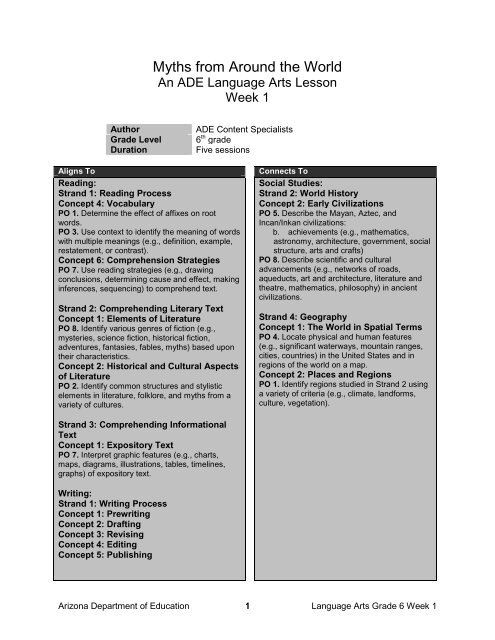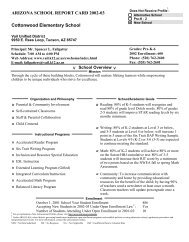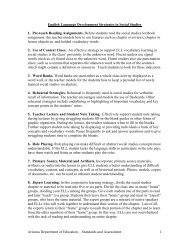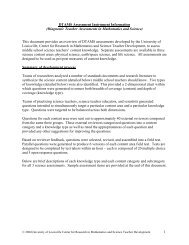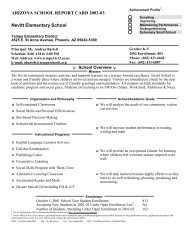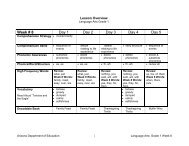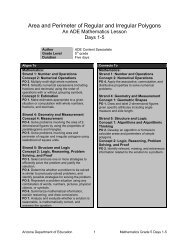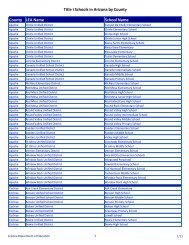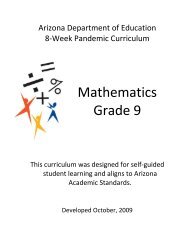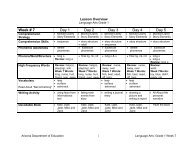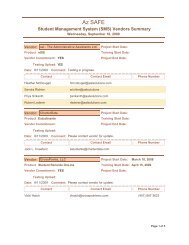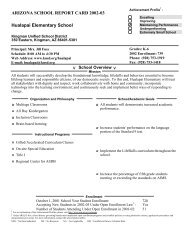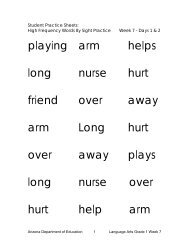Grade 6 Week 1 - Arizona Department of Education
Grade 6 Week 1 - Arizona Department of Education
Grade 6 Week 1 - Arizona Department of Education
You also want an ePaper? Increase the reach of your titles
YUMPU automatically turns print PDFs into web optimized ePapers that Google loves.
Myths from Around the World<br />
An ADE Language Arts Lesson<br />
<strong>Week</strong> 1<br />
Author<br />
<strong>Grade</strong> Level<br />
Duration<br />
ADE Content Specialists<br />
6 th grade<br />
Five sessions<br />
Aligns To<br />
Reading:<br />
Strand 1: Reading Process<br />
Concept 4: Vocabulary<br />
PO 1. Determine the effect <strong>of</strong> affixes on root<br />
words.<br />
PO 3. Use context to identify the meaning <strong>of</strong> words<br />
with multiple meanings (e.g., definition, example,<br />
restatement, or contrast).<br />
Concept 6: Comprehension Strategies<br />
PO 7. Use reading strategies (e.g., drawing<br />
conclusions, determining cause and effect, making<br />
inferences, sequencing) to comprehend text.<br />
Strand 2: Comprehending Literary Text<br />
Concept 1: Elements <strong>of</strong> Literature<br />
PO 8. Identify various genres <strong>of</strong> fiction (e.g.,<br />
mysteries, science fiction, historical fiction,<br />
adventures, fantasies, fables, myths) based upon<br />
their characteristics.<br />
Concept 2: Historical and Cultural Aspects<br />
<strong>of</strong> Literature<br />
PO 2. Identify common structures and stylistic<br />
elements in literature, folklore, and myths from a<br />
variety <strong>of</strong> cultures.<br />
Connects To<br />
Social Studies:<br />
Strand 2: World History<br />
Concept 2: Early Civilizations<br />
PO 5. Describe the Mayan, Aztec, and<br />
Incan/Inkan civilizations:<br />
b. achievements (e.g., mathematics,<br />
astronomy, architecture, government, social<br />
structure, arts and crafts)<br />
PO 8. Describe scientific and cultural<br />
advancements (e.g., networks <strong>of</strong> roads,<br />
aqueducts, art and architecture, literature and<br />
theatre, mathematics, philosophy) in ancient<br />
civilizations.<br />
Strand 4: Geography<br />
Concept 1: The World in Spatial Terms<br />
PO 4. Locate physical and human features<br />
(e.g., significant waterways, mountain ranges,<br />
cities, countries) in the United States and in<br />
regions <strong>of</strong> the world on a map.<br />
Concept 2: Places and Regions<br />
PO 1. Identify regions studied in Strand 2 using<br />
a variety <strong>of</strong> criteria (e.g., climate, landforms,<br />
culture, vegetation).<br />
Strand 3: Comprehending Informational<br />
Text<br />
Concept 1: Expository Text<br />
PO 7. Interpret graphic features (e.g., charts,<br />
maps, diagrams, illustrations, tables, timelines,<br />
graphs) <strong>of</strong> expository text.<br />
Writing:<br />
Strand 1: Writing Process<br />
Concept 1: Prewriting<br />
Concept 2: Drafting<br />
Concept 3: Revising<br />
Concept 4: Editing<br />
Concept 5: Publishing<br />
<strong>Arizona</strong> <strong>Department</strong> <strong>of</strong> <strong>Education</strong> 1<br />
Language Arts <strong>Grade</strong> 6 <strong>Week</strong> 1
Strand 2: Writing Components<br />
Concept 4: Word Choice<br />
PO 1. Use accurate, specific, powerful words that<br />
effectively convey the intended message.<br />
PO 2. Use words and phrases that consistently<br />
support style and type or writing.<br />
PO 3. Use vocabulary that is original, varied, and<br />
natural.<br />
PO 4. Use literal and figurative language where<br />
appropriate to purpose.<br />
Concept 6: Conventions<br />
PO 12. Use the following parts <strong>of</strong> speech correctly<br />
in simple sentences:<br />
d. adjectives<br />
Strand 3: Writing Applications<br />
Concept 1: Expressive<br />
PO 2. Write in a variety <strong>of</strong> expressive forms (e.g.,<br />
poetry, skit) that, according to mode, employ:<br />
a. figurative language<br />
c. dialogue<br />
d. characterization<br />
e. plot<br />
f. appropriate format<br />
Overview<br />
The oral tradition <strong>of</strong> storytelling is a part <strong>of</strong> every culture. Through a study <strong>of</strong> myths, you can<br />
learn about a civilization’s history and culture and can make connections between groups <strong>of</strong><br />
people around the world.<br />
Purpose<br />
In these five sessions, you will use myths from three civilizations around the world and<br />
expository passages on Greek geography and ancient art to support comprehension <strong>of</strong> literary<br />
and expository text, vocabulary development, and to practice writing a myth.<br />
Materials<br />
• Three myths reading passages<br />
• Geography <strong>of</strong> Greece reading passage<br />
• Myths in Ancient Art reading passage<br />
• Worksheets for the daily sessions<br />
• Pro<strong>of</strong>reading chart<br />
• Paper<br />
<strong>Arizona</strong> <strong>Department</strong> <strong>of</strong> <strong>Education</strong> 2<br />
Language Arts <strong>Grade</strong> 6 <strong>Week</strong> 1
Objectives<br />
Students will:<br />
• Read three different myths.<br />
• Read expository passages about geography and art.<br />
• Apply the skill <strong>of</strong> compare and contrast while reading.<br />
• Write a compare and contrast paragraph.<br />
• Use context to understand multiple-meaning words.<br />
• Apply knowledge <strong>of</strong> suffixes –ion and –ation.<br />
• Write a myth emphasizing the element <strong>of</strong> Word Choice.<br />
Lesson Components<br />
Prerequisite skills: The 5 Steps <strong>of</strong> the Writing Process have been used since <strong>Grade</strong> 1. Writing<br />
Elements have been used since Kindergarten. You should be familiar with these processes. All<br />
reading and grammar skills should have been introduced in prior grades and are reintroduced in<br />
the sessions and practiced. You should have knowledge <strong>of</strong> the physical landform peninsula.<br />
Session 1: Reading Comprehension and Writing<br />
1. Review story and genre vocabulary prior to reading.<br />
2. As a strategy to use during reading, review the skill <strong>of</strong> comparing and contrasting. This<br />
skill is applied while reading the myth, Prometheus and the Story <strong>of</strong> Fire.<br />
3. After reading the myth, check your comprehension by answering questions about the<br />
text.<br />
4. Read a short expository passage on the geography <strong>of</strong> Greece and answer questions<br />
about it.<br />
5. Begin Step 1 <strong>of</strong> the writing process in prewriting for a myth, emphasizing the element<br />
Word Choice.<br />
Session 2: Reading Comprehension, Vocabulary and Writing<br />
1. Review story vocabulary prior to reading.<br />
2. Compare and contrast as you read a second myth from Egypt titled, The Gifts <strong>of</strong> Osiris.<br />
3. After reading the myth, check your comprehension by answering questions about the<br />
text.<br />
4. Increase your vocabulary through a word study <strong>of</strong> multiple-meaning words by identifying<br />
the meaning <strong>of</strong> multiple-meaning words from the myth you read.<br />
5. Continue writing a draft <strong>of</strong> your myth.<br />
Session 3: Reading Comprehension, Phonics/Decoding and Writing<br />
1. Review story vocabulary prior to reading.<br />
2. Compare and contrast as you read a third myth from Mexico titled, Quetzalcoatl and the<br />
Discovery <strong>of</strong> Corn.<br />
3. After reading the myth, check your comprehension by answering questions about the<br />
text.<br />
4. Strengthen your reading skills by examining the use <strong>of</strong> the suffixes –ion and -ation in<br />
words and how this applies to your reading comprehension.<br />
5. Revise your myth, considering the use <strong>of</strong> Word Choice.<br />
<strong>Arizona</strong> <strong>Department</strong> <strong>of</strong> <strong>Education</strong> 3<br />
Language Arts <strong>Grade</strong> 6 <strong>Week</strong> 1
Session 4: Grammar and Writing<br />
1. Review adjectives that compare.<br />
2. Write a compare and contrast paragraph comparing two or all <strong>of</strong> the myths you have<br />
read this week. Use the graphic organizers created in Sessions 2 and 3 and include at<br />
least two comparative adjectives.<br />
3. Pro<strong>of</strong>read your myth.<br />
Session 5: Reading Comprehension and Writing<br />
1. Review story vocabulary prior to reading an expository passage titled, Myths in Ancient<br />
Art.<br />
2. After reading the passage, check your comprehension by answering questions about the<br />
text.<br />
3. Record an event from your myth through art.<br />
4. Create a final copy <strong>of</strong> your myth. Practice reading it and present it to a family member.<br />
Assessment<br />
There is one assessment for each session that will help you check your understanding before<br />
moving on to the next session.<br />
<strong>Arizona</strong> <strong>Department</strong> <strong>of</strong> <strong>Education</strong> 4<br />
Language Arts <strong>Grade</strong> 6 <strong>Week</strong> 1
Session 1 – Reading Comprehension and Writing<br />
Myths<br />
Vocabulary: Please review these words before you read the myth. These words will help you<br />
understand <strong>of</strong> elements <strong>of</strong> myths and comprehend the myth you will be reading.<br />
myth – a story that is part <strong>of</strong> the tradition <strong>of</strong> a society. They <strong>of</strong>ten use unusual plots and<br />
characters such as heroes or monsters to explain how the world began, why nature is<br />
the way it is or why people behave the way they do<br />
mythology – a collection <strong>of</strong> myths<br />
ancient – <strong>of</strong> or relating to times long ago<br />
characteristics – qualities <strong>of</strong> a person, group, or thing<br />
hero – in myths, it is a person who is brave, good, strong and <strong>of</strong>ten looked up to by others<br />
extraordinary – very unusual<br />
nature – the physical world and living things in their natural state<br />
Titans – in Greek mythology, giant godlike beings who were eventually defeated and replaced<br />
by the Olympian gods<br />
Mount Olympus – a mountain in northern Greece, believed in ancient times to be where<br />
Greek gods and goddesses lived<br />
stalk – the main stem <strong>of</strong> a plant<br />
reed – any <strong>of</strong> a variety <strong>of</strong> tall marsh grasses<br />
This week you will be reading three myths. Myths are stories that usually have been handed<br />
down from ancient times. They have been told over and over through the generations and have<br />
changed as they have been retold. Many different accounts <strong>of</strong> a myth may now exist. There are<br />
certain characteristics or features <strong>of</strong> myths that you should look for as you read.<br />
• Myths <strong>of</strong>ten explain why something in nature happens or how it first came about.<br />
• Characters in myths may include gods, goddesses and monsters as well as humans.<br />
• Human characters in myths may have superhuman strength or other abilities.<br />
• Myths may have extraordinary events.<br />
• Myths can show what an ancient group <strong>of</strong> people believed.<br />
Skill to use while reading: Compare and Contrast<br />
• To compare means to show how things are alike (similar).<br />
• To contrast means to show how things are different.<br />
As you read each myth, compare and contrast information to help organize and understand<br />
what you are reading. After reading all three myths, compare and contrast the information from<br />
each to better understand the genre <strong>of</strong> myths.<br />
<strong>Arizona</strong> <strong>Department</strong> <strong>of</strong> <strong>Education</strong> 5<br />
Language Arts <strong>Grade</strong> 6 <strong>Week</strong> 1
Myths<br />
From the earliest times, people around the world have used myths to explain how things<br />
came to be and why things are the way they are. You will read myths from three different<br />
civilizations around the world. The three myths you will read explain how a god in the culture<br />
gave something special to the people. As you read the three myths, think about ways in which<br />
the myths are similar and ways they differ.<br />
The first myth is from Greece. Greek mythology is the stories from Ancient Greece telling<br />
<strong>of</strong> their gods and heroes. The myths explain the nature <strong>of</strong> the world and were a part <strong>of</strong> religion<br />
in Ancient Greece. In this myth, Prometheus wishes to help humans by making their lives more<br />
comfortable.<br />
Prometheus and the Story <strong>of</strong> Fire<br />
Many, centuries ago there lived two brothers. Their names were Prometheus and<br />
Epimetheus. They were not like other men; they were the sons <strong>of</strong> Titans. Zeus, the king <strong>of</strong> the<br />
gods, instructed Epimetheus to create all the animals in the world. Then he asked Prometheus<br />
to make human beings to live in the world. He shaped them out <strong>of</strong> lumps <strong>of</strong> clay and breathed<br />
life into them.<br />
Prometheus did not care for the idle life among the gods on Mount Olympus. Instead he<br />
preferred to spend his time on the earth, helping men to find easier and better ways <strong>of</strong> living.<br />
The people <strong>of</strong> earth were very poor and miserable, living in caves and ditches and dying <strong>of</strong><br />
starvation and cold. They had no fire and little food; hunted by wild beasts and by one another.<br />
Prometheus thought <strong>of</strong> a way to help the people. He decided that fire would be a<br />
valuable gift. "If they had fire," Prometheus said to himself, "they would be able to cook their<br />
food, have light at night, warm themselves and frighten away the wild beasts that hunt them.”<br />
But fire belonged to the gods and Prometheus knew they would not share this power with the<br />
humans. So he decided he would have to steal it.<br />
Prometheus found a reed that was hollow and that would burn slowly. He could use this<br />
to carry fire down to the people <strong>of</strong> earth. Immediately, taking the long stalk in his hands, he set<br />
out for the dwelling <strong>of</strong> the gods on Olympus. He quietly entered Olympus and went to the sacred<br />
hearth where fire was burning. Lighting his reed, he hurried back to earth, carefully protecting<br />
the precious spark that was hidden in the hollow stalk.<br />
When he returned to earth, he showed the people how to build fire for themselves. They<br />
warmed themselves and soon learned to cook. Eventually they learned to plant the fields to<br />
grow food and to build homes <strong>of</strong> wood and stone. Prometheus was pleased to see the people<br />
happy and living a better life.<br />
<strong>Arizona</strong> <strong>Department</strong> <strong>of</strong> <strong>Education</strong> 6<br />
Language Arts <strong>Grade</strong> 6 <strong>Week</strong> 1
Check your understanding <strong>of</strong> the myth, Prometheus and the Story <strong>of</strong> Fire. You may look back at<br />
the story. Answer in complete sentences.<br />
1. The myth does not describe Prometheus’ life on earth before he brought fire to humans.<br />
What can you infer about the way he lived Did he live like the humans Describe the way<br />
you think he might have lived.<br />
2. What extraordinary or supernatural powers did Prometheus possess<br />
3. Use the compare-and-contrast chart to record similarities and differences in the lives <strong>of</strong><br />
characters in the story. Place a check mark in the boxes that match what you read in the<br />
story.<br />
Lived or spent<br />
time on Mount<br />
Olympus<br />
Lived or spent<br />
time on earth<br />
Had fire<br />
Had supernatural<br />
powers<br />
Prometheus<br />
Zeus<br />
humans<br />
4. The story <strong>of</strong> Prometheus explains how something in nature came to be. However there are<br />
other events mentioned in the myth. What other events are explained in this myth<br />
<strong>Arizona</strong> <strong>Department</strong> <strong>of</strong> <strong>Education</strong> 7<br />
Language Arts <strong>Grade</strong> 6 <strong>Week</strong> 1
Geography <strong>of</strong> Greece<br />
The ancient civilization <strong>of</strong> Greece was located where the modern country <strong>of</strong> Greece is<br />
found. It is a country on the continent <strong>of</strong> Europe. Locate Greece on the map below. It is in the<br />
southeastern corner. (North is to the top.)<br />
Map courtesy <strong>of</strong> the Central Intelligence Agency<br />
<strong>Arizona</strong> <strong>Department</strong> <strong>of</strong> <strong>Education</strong> 8<br />
Language Arts <strong>Grade</strong> 6 <strong>Week</strong> 1
You can see that Greece is a peninsula with many islands around it. The peninsula is<br />
very mountainous. Both the mountains and islands were very important to the history <strong>of</strong> Ancient<br />
Greece. The mountains made travel between city-states very difficult and so the different<br />
communities developed their own ways <strong>of</strong> life. Many Greeks lived on islands and so they sailed<br />
the Aegean and Mediterranean Seas spreading the Greek Culture throughout this area.<br />
Mount Olympus, the mythical home <strong>of</strong> the gods, is an actual mountain in Greece.<br />
Reaching over 9,500 feet high, it is the highest mountain in Greece. It is located near the<br />
Aegean Sea in northern Greece, about 60 miles from Thessaloniki, Greece’s second largest<br />
city. Find Thessaloniki on the map above. In ancient times, Thessaloniki was not part <strong>of</strong> Greece.<br />
Courtesy NASA.gov<br />
The image above is a NASA photograph <strong>of</strong> Mount Olympus from space. Look closely<br />
and you can see the snow-capped Mount Olympus. Can you see that it is located near a bay in<br />
the Aegean Sea Using the geographic features you see here, match the location <strong>of</strong> the NASA<br />
image on the map <strong>of</strong> Europe above. You should be able to locate the bay in the Aegean Sea.<br />
The photo on the left shows Mount<br />
Olympus, rising over 9,500 feet from sea level.<br />
Notice how rugged the mountains are and how<br />
travel across them would have been very difficult.<br />
http://en.wikipedia.org/wiki/File:Olympus_Litochoro.JPG<br />
In ancient times, the city-states <strong>of</strong> Athens<br />
and Sparta were located in the southern part <strong>of</strong><br />
Greece. You can find the modern city <strong>of</strong> Athens,<br />
the capital <strong>of</strong> Greece on the map above. Ancient<br />
Greeks also lived on the islands in the Aegean<br />
Sea. Do you think snow-capped Mount Olympus,<br />
rising high in the mountains to the north, would<br />
have seemed a proper home for their gods and<br />
goddesses<br />
<strong>Arizona</strong> <strong>Department</strong> <strong>of</strong> <strong>Education</strong> 9<br />
Language Arts <strong>Grade</strong> 6 <strong>Week</strong> 1
Check your understanding <strong>of</strong> Greek geography by answering the questions below. You may<br />
look back at the passage Geography <strong>of</strong> Greece.<br />
1. What part did the mountains and sea play in ancient Greek history<br />
2. Circle the following locations on the map <strong>of</strong> Europe: Greece; Aegean Sea, Mediterranean<br />
Sea.<br />
3. Describe a peninsula as a physical feature.<br />
4. Greece is a peninsula. Use the map <strong>of</strong> Europe to locate another peninsula. Circle it and<br />
write the name <strong>of</strong> the country or countries that occupy the peninsula below.<br />
5. Locate the following physical features on the NASA image.<br />
a. Put an X on the bay.<br />
b. Circle Mount Olympus<br />
c. Circle the small peninsula<br />
d. Draw a box around a lake<br />
6. Why do you think snow-capped Mount Olympus, rising high in the mountains to the north,<br />
would have seemed like the home <strong>of</strong> their gods and goddesses to Ancient Greeks<br />
<strong>Arizona</strong> <strong>Department</strong> <strong>of</strong> <strong>Education</strong> 10<br />
Language Arts <strong>Grade</strong> 6 <strong>Week</strong> 1
Writing Activity<br />
Now that you have read a myth, you will write one <strong>of</strong> your own. Over the next five sessions, you<br />
will work through the steps <strong>of</strong> writing a myth. You will focus on the writing component Word<br />
Choice.<br />
Step 1: Prewriting – Start planning your myth. It must have all <strong>of</strong> the characteristics <strong>of</strong> a myth.<br />
• A main character who could be a god or goddess or a human with superhuman strength<br />
or ability.<br />
• A setting. Where will your character live and the story take place<br />
• A problem. What problem will your hero/heroine solve with their godly or superhuman<br />
qualities A myth <strong>of</strong>ten explains why something in nature happens or why it first came<br />
about.<br />
Use the following chart to help you organize your ideas for writing a myth.<br />
In the next session, you will put your ideas together into a draft myth.<br />
<strong>Arizona</strong> <strong>Department</strong> <strong>of</strong> <strong>Education</strong> 11<br />
Language Arts <strong>Grade</strong> 6 <strong>Week</strong> 1
<strong>Arizona</strong> <strong>Department</strong> <strong>of</strong> <strong>Education</strong> 12<br />
Language Arts <strong>Grade</strong> 6 <strong>Week</strong> 1
Session 2 – Comprehension, Vocabulary and Writing<br />
Vocabulary: Please review these words before you read the myth. These words will help you<br />
comprehend the myth you will be reading.<br />
pharaoh – the title <strong>of</strong> each <strong>of</strong> the kings <strong>of</strong> Ancient Egypt<br />
upright – right, honest, and just in actions or morals<br />
serene – free from trouble; calm<br />
savage – fierce; cruel<br />
brutal – cruel<br />
barley – a plant that is like grass and whose grains are used for food<br />
Nile River – the longest river in the world; It flows north from Uganda in East Africa through<br />
Sudan and Egypt into the Mediterranean Sea.<br />
harvest – the gathering <strong>of</strong> ripe crops<br />
persuasion – the ability to convince someone to believe something or do something<br />
As you read, remember that there are certain characteristics or features <strong>of</strong> myths that you<br />
should look for as you read.<br />
• Myths <strong>of</strong>ten explain why something in nature happens or how it first came about<br />
• Characters in myths may include gods, goddesses and monsters as well as humans<br />
• Human characters in myths may have superhuman strength or other abilities<br />
• Myths may have extraordinary events<br />
• Myths can show what an ancient group <strong>of</strong> people believed<br />
Also remember to use the Compare and Contrast skill while reading:<br />
• To compare means to show how things are alike (similar).<br />
• To contrast means to show how things are different.<br />
As you read today’s myth, compare and contrast it to the Greek myth you read yesterday.<br />
Reread the Greek myth if you need to.<br />
The second myth is from Egypt. Religion was important to the lives <strong>of</strong> Ancient Egyptians. Their<br />
life centered on the worship <strong>of</strong> the Egyptian gods. Stories <strong>of</strong> the gods would explain aspects <strong>of</strong><br />
nature or how things came to be. This next myth tells how the god Osiris helped the people <strong>of</strong><br />
Egypt.<br />
<strong>Arizona</strong> <strong>Department</strong> <strong>of</strong> <strong>Education</strong> 13<br />
Language Arts <strong>Grade</strong> 6 <strong>Week</strong> 1
The Gifts <strong>of</strong> Osiris<br />
In the beginning <strong>of</strong> time the god Osiris was king over Egypt. Osiris was the son <strong>of</strong> the<br />
sky goddess Nut and the earth god Geb. Osiris was the first pharaoh and Isis was his queen.<br />
He is known as a just and upright ruler, much loved by his people.<br />
But when Osiris first came to the throne, Egypt was not a serene, farming civilization. At<br />
this time the Egyptians were cruel and uncivilized. They wandered around in tribes, hunting wild<br />
animals. They fought with one another. Among the savage acts they committed was that they<br />
killed and ate each other. Osiris saw this and was greatly disturbed. He realized he must help<br />
his people and so he went out among them and began teaching them how to worship the gods.<br />
Osiris also gave them laws to end their brutal behavior.<br />
However the greatest gift <strong>of</strong> Osiris to the people <strong>of</strong> Egypt was that he taught them what<br />
to eat. He gave them the gift <strong>of</strong> agriculture. This is how he did it. Isis, the wife <strong>of</strong> Osiris,<br />
discovered wheat and barley grasses growing wild in the fields near the Nile River. When she<br />
showed the wild grains to Osiris, he walked among them and noticed how some <strong>of</strong> the ripened<br />
grains fell to the ground. He realized that those seeds would grow again the next year, while<br />
seeds that blew away in the wind would not. So he taught his people how to gather the ripened<br />
grains, how to plant them in the ground and tend to them. In this way his people would have<br />
food that would grow in the same place from year to year. No longer would they have to kill one<br />
another for food.<br />
It is said that Osiris also taught his people to gather fruit from the trees, to train vine<br />
plants to grow on poles, to harvest grapes and then tramp on them to create juice. All this he did<br />
because he cared for his people and wanted them to live better lives. He is known as Egypt’s<br />
greatest king who ruled through kindness and persuasion.<br />
<strong>Arizona</strong> <strong>Department</strong> <strong>of</strong> <strong>Education</strong> 14<br />
Language Arts <strong>Grade</strong> 6 <strong>Week</strong> 1
Check your understanding <strong>of</strong> the myth, The Gifts <strong>of</strong> Osiris. You may look back at the story.<br />
Answer in complete sentences.<br />
1. Myths <strong>of</strong>ten have gods or goddesses as characters. Is Osiris a god Explain why you<br />
believe he is or is not.<br />
2. Describe why Osiris was disturbed by the actions <strong>of</strong> his people when he first came to the<br />
throne.<br />
3. What was Osiris’ greatest gift to his people<br />
4. What other gifts did he give his people (4 answers)<br />
5. You were asked to compare and contrast this myth with the Greek myth you read yesterday.<br />
One tool used to show comparisons and contrasts is a graphic organizer called a Venn<br />
diagram.<br />
Use the Venn diagram below to list ways in which the two myths are similar and different. Write<br />
Prometheus next to one circle and Osiris next to the other. Write ways in which the myths are<br />
different in the areas that do not overlap. Write ways in which the myths are similar in the area<br />
where the circles overlap.<br />
<strong>Arizona</strong> <strong>Department</strong> <strong>of</strong> <strong>Education</strong> 15<br />
Language Arts <strong>Grade</strong> 6 <strong>Week</strong> 1
<strong>Arizona</strong> <strong>Department</strong> <strong>of</strong> <strong>Education</strong> 16<br />
Language Arts <strong>Grade</strong> 6 <strong>Week</strong> 1
Vocabulary<br />
Multiple-meaning words<br />
Many words have more than one meaning. They are called multiple-meaning words.<br />
An example is: match.<br />
• Match can be a noun meaning a small piece <strong>of</strong> wood with a tip that catches fire.<br />
• Match can also be a noun meaning a contest or a game.<br />
• Match can also have other meanings.<br />
A dictionary can show you all <strong>of</strong> the different meanings <strong>of</strong> a word.<br />
The context <strong>of</strong> the word is used in to help you understand multiple-meaning words.<br />
For example, read these two sentences.<br />
Mom used a match to light the campfire.<br />
Bill was ready to play the tennis match.<br />
In these sentences, the word match has different meanings, but you can use context to figure<br />
out what they mean.<br />
• In the first sentence, Mom started a campfire, so match must mean a small piece <strong>of</strong><br />
wood with a tip that catches fire.<br />
• In the second sentence, Bill is playing, so match must mean a contest or a game.<br />
<strong>Arizona</strong> <strong>Department</strong> <strong>of</strong> <strong>Education</strong> 17<br />
Language Arts <strong>Grade</strong> 6 <strong>Week</strong> 1
Multiple-meaning Word Practice<br />
Below are five sentences from the myth <strong>of</strong> Osiris. They all have an underlined multiple-meaning<br />
word (one sentence has two words). Use context to decide which dictionary entry <strong>of</strong> the word is<br />
used in the sentence. Write the correct definition in the space. Use the context the word is<br />
used in to help you understand its meaning. You may go back and reread the myth if you wish.<br />
1. He is known as a just and upright ruler, much loved by his people.<br />
just (just) adj. 1. fair and honest 2. having a fair and honest character 3. deserved or<br />
earned adv. 1. a very short time ago 2. only 3. by a very small margin; barely 4. exactly<br />
2. Among the savage acts they committed was that they killed and ate each other.<br />
act (akt) n. pl. acts 1. a thing that is done; a deed 2. an action 3. a law 4. pretending to be<br />
or to feel something that is not true 5. one <strong>of</strong> the main parts <strong>of</strong> a play or opera v.<br />
acted, acting, acts 1. to do something with purpose or energy 2. to be a performer in plays<br />
or movies 3. to pretend to be<br />
3. So he taught his people how to gather the ripened grains, how to plant them in the ground<br />
and tend to them.<br />
tend (tend) v. 1. to care for or watch over; look after 2. to give one's attention to 3. to be<br />
likely; usually do<br />
4. It is said that Osiris also taught his people to gather fruit from the trees, to train vine plants to<br />
grow on poles, to harvest grapes and then tramp on them to create juice.<br />
train (trān) n. 1. a connected series <strong>of</strong> railroad cars 2. a long, moving line <strong>of</strong> persons,<br />
animals, or vehicles 3. a series <strong>of</strong> things or ideas 4. the long part <strong>of</strong> a gown or robe that<br />
trails behind the person wearing it v. 1 to teach skills or actions. 2. to instruct 3. to make fit<br />
through a program <strong>of</strong> exercise and diet 4. to prepare oneself to be in an athletic contest<br />
tramp (tramp) v. 1. to walk with heavy steps 2. to step on with force on or upon 3. to walk<br />
with steady, even steps; march; hike n. 1. a heavy step, or the sound made by a heavy step<br />
2. a long walk at a steady pace; a march; a hike 3. a person who travels on foot from town<br />
to town and who lives by begging or doing odd jobs<br />
<strong>Arizona</strong> <strong>Department</strong> <strong>of</strong> <strong>Education</strong> 18<br />
Language Arts <strong>Grade</strong> 6 <strong>Week</strong> 1
Now select two different definitions for each multiple-meaning word and write sentences using<br />
the word with each <strong>of</strong> those definitions.<br />
5. just<br />
6. just<br />
7. acts<br />
8. acts<br />
9. tend<br />
10. tend<br />
11. train<br />
12. train<br />
13. tramp<br />
14. tramp<br />
Presenting – Read the sentence from the myth and your two sentences for each multiplemeaning<br />
word to a family member. Explain to them how the context <strong>of</strong> the sentence helps you<br />
to understand which definition <strong>of</strong> the word is being used.<br />
<strong>Arizona</strong> <strong>Department</strong> <strong>of</strong> <strong>Education</strong> 19<br />
Language Arts <strong>Grade</strong> 6 <strong>Week</strong> 1
Writing Activity<br />
In Session 1 you planned for writing a myth. You created a chart to help you plan your main<br />
character, the setting, and a problem for your character to solve. You may have also added<br />
extraordinary events to occur while solving the problem.<br />
You will work on Word Choice in this writing activity. You want to give a feeling <strong>of</strong> power and<br />
wonder suitable for a myth. You may want to include dialogue or figurative language to add<br />
interest to your story.<br />
Step 2: Drafting – Use the steps below to draft your myth:<br />
1. Introduce the character in an interesting way. Remember that they are a larger-than-life<br />
character. Use words that describe them suitably!<br />
2. In the following paragraphs, tell about the problem and how your character solves it in an<br />
extraordinary way. Make it interesting to the reader.<br />
When writing a draft, don’t worry too much about spelling, punctuation or grammar. You can<br />
make corrections later. It’s more important to get all <strong>of</strong> your thoughts and ideas down in the way<br />
you want to say them. Use pencil so that you can make changes as you write.<br />
Write your draft on a sheet <strong>of</strong> paper.<br />
<strong>Arizona</strong> <strong>Department</strong> <strong>of</strong> <strong>Education</strong> 20<br />
Language Arts <strong>Grade</strong> 6 <strong>Week</strong> 1
Session 3 – Comprehension, Phonics/Decoding and Writing<br />
Vocabulary: Please review these words before you read the myth. These words will help you<br />
comprehend the myth you will be reading.<br />
Aztec – an Indian people who had an advanced civilization in central Mexico before Spain<br />
conquered it in 1519<br />
creation – the act <strong>of</strong> creating or <strong>of</strong> causing something to exist<br />
serpent – a snake<br />
sustenance – nourishment; food<br />
Remember that there are certain characteristics or features <strong>of</strong> myths that you should look for as<br />
you read.<br />
• Myths <strong>of</strong>ten explain why something in nature happens or how it first came about.<br />
• Characters in myths may include gods, goddesses, and monsters as well as humans.<br />
• Human characters in myths may have superhuman strength or other abilities.<br />
• Myths may have extraordinary events.<br />
• Myths can show what an ancient group <strong>of</strong> people believed.<br />
Also remember to use the Compare and Contrast skill while reading:<br />
To compare means to show how things are alike (similar).<br />
To contrast means to show how things are different.<br />
As you read today’s myth, compare and contrast it to both the Greek and the Egyptian myths<br />
you have already read. Reread those myths if you need to.<br />
This myth is from the Aztec civilization <strong>of</strong> Mexico. In this story based on the Legend <strong>of</strong> the Suns,<br />
the Aztec age <strong>of</strong> the Fifth Sun has just begun. However, a problem exists for the humans and<br />
fortunately Quetzalcoatl (ket sahl koh AHT l) is there to help.<br />
<strong>Arizona</strong> <strong>Department</strong> <strong>of</strong> <strong>Education</strong> 21<br />
Language Arts <strong>Grade</strong> 6 <strong>Week</strong> 1
Quetzalcoatl and the Discovery <strong>of</strong> Corn<br />
According to Aztec legend, there were four destroyed worlds that existed before the<br />
creation <strong>of</strong> the Fifth Sun (this world and time). The earth and sky had been created in the Fifth<br />
Sun and humans had been brought to life by the gods. Quetzalcoatl, the feathered serpent god,<br />
had helped create the new world and the humans. When the work <strong>of</strong> creation was finished, the<br />
gods looked upon the beautiful green earth, the bright blue sky, the shimmering seas and the<br />
newly-formed humans. As they gazed at the humans, they noticed how weak they seemed and<br />
realized that their work was not done. The humans needed food to keep them alive.<br />
The gods decided that they must look for food for the humans to eat, but what should<br />
they look for As they all thought about this, Quetzalcoatl looked down and saw a small, red ant<br />
that was carrying a kernel <strong>of</strong> corn in its mouth. He asked, “Where did you get this corn” The ant<br />
did not answer, but continued walking. So, Quetzalcoatl turned himself into a black ant and<br />
followed her.<br />
At last they came to the bottom <strong>of</strong> a large mountain called the Mountain <strong>of</strong> Sustenance.<br />
The small red ant, not knowing the black ant was Quetzalcoatl, went inside this mountain.<br />
Quetzalcoatl followed, and found inside many things that were good to eat. He quickly gathered<br />
some corn and returned to the world <strong>of</strong> the gods. The gods chewed on the corn to make a paste<br />
and Quetzalcoatl placed it on the lips <strong>of</strong> the humans, who were weak with hunger. The humans<br />
became stronger and honored the gods who had saved them.<br />
Next the gods thought about what to do with the Mountain <strong>of</strong> Sustenance and all that<br />
was inside it. Quetzalcoatl wanted to give the food inside to the people so that they would<br />
worship the gods. At first, Quetzalcoatl tried to drag the mountain to the home <strong>of</strong> the gods, but<br />
the mountain would not move. Next, the gods broke it open with a stick and took the corn,<br />
beans, and everything else good to eat from inside. This is how Quetzalcoatl gave humans food<br />
to plant and to live.<br />
<strong>Arizona</strong> <strong>Department</strong> <strong>of</strong> <strong>Education</strong> 22<br />
Language Arts <strong>Grade</strong> 6 <strong>Week</strong> 1
Check your understanding <strong>of</strong> the myth, Quetzalcoatl and the Discovery <strong>of</strong> Corn. You may look<br />
back at the story. Answer in complete sentences.<br />
1. What event or events in nature are explained in this myth<br />
2. How did Quetzalcoatl help humans<br />
3. What method did Quetzalcoatl use to get what he wanted from the ant<br />
4. Compare and contrast the three myths. Use the compare-and-contrast chart to record<br />
similarities and differences in the three myths. Place a check mark in the boxes that match<br />
what you read in each myth.<br />
Main<br />
character<br />
was a god<br />
or<br />
goddess<br />
Explained<br />
why<br />
something<br />
in nature<br />
happened<br />
or first<br />
occurred<br />
Humans<br />
were<br />
miserable<br />
and wild<br />
before<br />
being<br />
helped<br />
Main<br />
character<br />
used supernatural<br />
powers to<br />
help<br />
humans<br />
Human<br />
had superhuman<br />
strength or<br />
ability<br />
Myth shows<br />
what an<br />
ancient<br />
group <strong>of</strong><br />
people<br />
believed<br />
Prometheus<br />
and the Gift<br />
<strong>of</strong> Fire<br />
The Gifts <strong>of</strong><br />
Osiris<br />
Quetzalcoatl<br />
and the<br />
Discovery <strong>of</strong><br />
Corn<br />
<strong>Arizona</strong> <strong>Department</strong> <strong>of</strong> <strong>Education</strong> 23<br />
Language Arts <strong>Grade</strong> 6 <strong>Week</strong> 1
Suffixes<br />
When reading, you will come across words that contain suffixes. Suffixes are word parts added<br />
to the end <strong>of</strong> base words. Sometimes the suffix changes the way the word is used. You will be a<br />
better reader if you recognize suffixes and understand how they change the meaning and<br />
pronunciation <strong>of</strong> a base word.<br />
Read this sentence.<br />
Fire became a possession <strong>of</strong> humans after Prometheus stole it from the gods.<br />
• Notice the suffix –ion in the underlined word possession. (possession)<br />
• The suffix –ion can mean “state or condition” or “action or process.”<br />
• The base word <strong>of</strong> possession is possess. Possess means “to own or to have.”<br />
• When you add the suffix –ion to the base word, the new word possession means “the<br />
state <strong>of</strong> having.”<br />
• Possess is a verb; possession is a noun. The suffix –ion is called a noun suffix because<br />
it <strong>of</strong>ten changes a verb to a noun.<br />
• The suffix –ation is another noun suffix that can mean the same as –ion. Example: tax<br />
and taxation<br />
• There may be spelling changes in the verb before the suffix is added. For example a<br />
final –e may be dropped when you change congratulate to congratulation.<br />
Practice with these sentences from the myths you read.<br />
Read each sentence. Circle the suffix in each underlined word. Write the meaning <strong>of</strong> the<br />
underlined word under the sentence.<br />
“The people <strong>of</strong> earth were very poor and miserable, living in caves and ditches and dying <strong>of</strong><br />
starvation and cold.”<br />
“According to Aztec legend, there were four destroyed worlds that existed before the creation <strong>of</strong><br />
the Fifth Sun (this world and time).”<br />
Why is it important to know about suffixes When you read and see a word you don’t know,<br />
look at the word parts. Look for a suffix. If it has the suffix –ion or –ation, you know it is used to<br />
make a noun from a verb. Look at the base word. Try to pronounce it. Was there a spelling<br />
change made when the suffix was added Was a silent –e dropped Read the word in the<br />
sentence. Does the new noun make sense in the sentence<br />
Practice with this sentence:<br />
The humans showed their appreciation to Osiris by living the way he wanted them to.<br />
Were you able to pronounce the word with the suffix Explain your thinking to a family member.<br />
<strong>Arizona</strong> <strong>Department</strong> <strong>of</strong> <strong>Education</strong> 24<br />
Language Arts <strong>Grade</strong> 6 <strong>Week</strong> 1
Suffix Practice<br />
Read each sentence and circle the suffix –ion or -ation in the underlined words. Then use the<br />
underlined word in a sentence <strong>of</strong> your own.<br />
1. Migration <strong>of</strong> the Monarch butterflies in North America occurs every year.<br />
2. The Earth’s rotation takes 24 hours, or one day.<br />
3. A period <strong>of</strong> relaxation was very refreshing for the hikers.<br />
4. Concentration was extremely important if Bill was going to finish the test on time.<br />
5. Scientists were looking for signs <strong>of</strong> pollution in the city’s water source.<br />
Writing Activity<br />
Step 3: Revising – Today you will revise your draft myth. Read it over to be sure you have<br />
followed the two steps from Session 2. Think about how you can make your myth more<br />
interesting to the reader. Try reading it aloud to see how it will sound to your audience. You<br />
want them to be interested in what you are saying and entertained by the story. Remember that<br />
you are focusing on Word Choice. Use words that would be suitable for characters and events<br />
in a myth. Make changes in your draft.<br />
<strong>Arizona</strong> <strong>Department</strong> <strong>of</strong> <strong>Education</strong> 25<br />
Language Arts <strong>Grade</strong> 6 <strong>Week</strong> 1
Session 4 – Grammar and Writing<br />
Adjectives That Compare<br />
Review adjectives:<br />
• Adjectives are words that describe or change a noun (a person or thing) in a sentence.<br />
• The articles - a, an, and the - are adjectives.<br />
• An adjective usually comes right before the noun it is describing.<br />
Examples: The adjectives are underlined.<br />
the tall student<br />
the happy baby<br />
Adjectives can also be used to compare things. When you use adjectives to compare,<br />
remember these rules:<br />
• When you compare two things, add –er to most adjectives. Use the word more with<br />
longer adjectives. This is the comparative form.<br />
• When you compare three or more things, add –est to most adjectives. Use the word<br />
most with longer adjectives. This is the superlative form.<br />
For example:<br />
This month is hot.<br />
This month is hotter than last month.<br />
This month is the hottest month we have had all year.<br />
• Some adjectives have special forms for comparing. (bad, worse, worst)<br />
Adjective Practice<br />
Write the correct form <strong>of</strong> the adjective in parentheses.<br />
1. The mountains are (high) than the hills.<br />
2. This is the (good) hamburger I have ever had!<br />
3. I am the (tall) person in my family.<br />
4. The librarians at the public library were the (helpful) people <strong>of</strong> all.<br />
5. Maria was (busy) than she had been since school had started.<br />
<strong>Arizona</strong> <strong>Department</strong> <strong>of</strong> <strong>Education</strong> 26<br />
Language Arts <strong>Grade</strong> 6 <strong>Week</strong> 1
Compare and contrast paragraph<br />
In the space below, write a paragraph comparing two or all three <strong>of</strong> the myths you have read<br />
this week.<br />
• Use your Venn diagram chart from Session 2 or the comparison chart from Session<br />
3 to help you.<br />
• In your topic sentence, state which myths you will be comparing.<br />
• Write details that compare and details that contrast in your supporting sentences.<br />
• Group the details together by those that compare and those that contrast.<br />
• Use at least two comparative adjectives in your paragraph.<br />
After you write your paragraph, read it over and think about what you wrote. Make any changes<br />
in content or grammar, spelling and usage that you think are needed. Remember to use the<br />
correct form <strong>of</strong> adjectives when you compare.<br />
<strong>Arizona</strong> <strong>Department</strong> <strong>of</strong> <strong>Education</strong> 27<br />
Language Arts <strong>Grade</strong> 6 <strong>Week</strong> 1
Writing Activity<br />
Step 4: Pro<strong>of</strong>reading – Today you will check your myth for errors in grammar, spelling,<br />
punctuation, and usage <strong>of</strong> words.<br />
Here are some suggestions as you pro<strong>of</strong>read:<br />
• Check for only one type <strong>of</strong> error each time you read your myth.<br />
o For example, check only for capital letter mistakes the first time you read it.<br />
o Then check for punctuation mistakes the next time.<br />
o Then check for spelling errors.<br />
o<br />
o<br />
Last <strong>of</strong> all, check your usage <strong>of</strong> words.<br />
If you concentrate on looking only for one kind <strong>of</strong> error, it will be easier to find<br />
them.<br />
• When you have finished, wait for a while and then read it aloud again with fresh eyes to<br />
see how it sounds.<br />
• Remember to apply what you have learned this week about multiple meaning words,<br />
suffixes, and comparative adjectives.<br />
• Use the pro<strong>of</strong>reading marks that you have been taught in your classes. A chart is<br />
available for you to use as you pro<strong>of</strong>read. Make all changes in your draft.<br />
<strong>Arizona</strong> <strong>Department</strong> <strong>of</strong> <strong>Education</strong> 28<br />
Language Arts <strong>Grade</strong> 6 <strong>Week</strong> 1
Session 5– Reading Comprehension and Writing<br />
Myths in Ancient Art<br />
Vocabulary: Please review these words before you read the passage on ancient art.<br />
images – pictures or some other likeness <strong>of</strong> a person or thing<br />
scene – a particular view in a painting or photograph<br />
manuscript – a handwritten text<br />
pictorial – made <strong>of</strong> pictures<br />
famine – a great lack <strong>of</strong> food over a wide area<br />
This week you read three myths. As you know, myths are stories that usually have been<br />
handed down from ancient times. They have been told over and over through the generations.<br />
However, myths were not only passed down through oral tradition. They were also remembered<br />
through the art <strong>of</strong> the culture.<br />
The first myth you read was from Ancient Greece. In that myth, Prometheus helped<br />
humans by giving them the gift <strong>of</strong> fire. Images <strong>of</strong> Greek gods and goddesses <strong>of</strong>ten decorated<br />
the pottery <strong>of</strong> the Greeks. Larger vases <strong>of</strong>ten had scenes from Greek myths painted on them.<br />
Many examples <strong>of</strong> the pottery have survived. Below is an example <strong>of</strong> a plate showing a painting<br />
<strong>of</strong> Prometheus with Hera, the wife <strong>of</strong> Zeus. Do you recall who Zeus was from your reading<br />
http://commons.wikimedia.org<br />
Prometheus and Hera, the wife <strong>of</strong> Zeus (5th-century plate)<br />
With the help <strong>of</strong> Prometheus, the people <strong>of</strong> Greece learned to plant fields and grow food<br />
for themselves. This idea is shown in the scene painted on the vase in the next picture. In it,<br />
olives are being gathered from trees. According to Greek myth, humans learned growing plants<br />
and harvesting from Prometheus.<br />
<strong>Arizona</strong> <strong>Department</strong> <strong>of</strong> <strong>Education</strong> 29<br />
Language Arts <strong>Grade</strong> 6 <strong>Week</strong> 1
http://worldimages.sjsu.edu/<br />
Gathering Olives<br />
The second myth you read was from Egypt. Religion was important to the lives <strong>of</strong><br />
Ancient Egyptians. Their life centered on the worship <strong>of</strong> the Egyptian gods. Stories <strong>of</strong> the gods<br />
explained features <strong>of</strong> nature or how things came to be. You read a myth about the god Osiris.<br />
To the left is a painting <strong>of</strong> the Egyptian god<br />
Osiris. After his death, he became the god <strong>of</strong> the<br />
underworld. He was always pictured with a green<br />
body. The painting is a part <strong>of</strong> a page from an<br />
Egyptian manuscript known as the Book <strong>of</strong> the<br />
Dead. This was a collection <strong>of</strong> prayers and spells<br />
that guided a person into the next life. Below you<br />
can see the entire page from the book.<br />
www.egyptarchive.co.uk/html/british_museum_35.html<br />
www.egyptarchive.co.uk/html/british_museum_35.html<br />
Osiris, god <strong>of</strong> the Underworld<br />
The myth you read told how the god Osiris<br />
helped the people <strong>of</strong> Egypt by giving them the gift<br />
<strong>of</strong> agriculture. The importance <strong>of</strong> agriculture to the<br />
Egyptians is shown in the painting below.<br />
<strong>Arizona</strong> <strong>Department</strong> <strong>of</strong> <strong>Education</strong> 30<br />
Language Arts <strong>Grade</strong> 6 <strong>Week</strong> 1
http://worldimages.sjsu.edu/<br />
Tomb <strong>of</strong> Sennadjem: Harvest scene<br />
The harvest scene shown above was painted in a tomb in Egypt over 3000 years ago.<br />
Most <strong>of</strong> the art that survives from Ancient Egypt is from tombs and pyramids, so it <strong>of</strong>ten deals<br />
with life after death. Having a painting <strong>of</strong> a grain harvest shows this is something important to<br />
have in the afterlife.<br />
Egyptian art usually shows people’s faces from the side or pr<strong>of</strong>ile. Do you see this in<br />
both <strong>of</strong> the paintings above Sometimes the body is not shown from the side, even when the<br />
head is. Can you find an example <strong>of</strong> this in one <strong>of</strong> the paintings<br />
The third myth you read was from the Aztec civilization <strong>of</strong> Mexico. In that story based on<br />
the Legend <strong>of</strong> the Suns, a problem exists for the newly-formed humans. As with the other<br />
ancient civilizations, Aztec gods were shown through art.<br />
The Aztec created pictorial manuscripts called codices. One <strong>of</strong> these manuscripts is<br />
called a codex. Some were created before the Spanish arrived in the Americas and some after.<br />
Those made before the Spanish arrived are called pre-Columbian. Those after the arrival <strong>of</strong> the<br />
Spanish are called colonial. They were all created by the Aztec.<br />
A codex was usually made on a long strip <strong>of</strong> paper called amatl, made from the bark <strong>of</strong> a<br />
tree. Pictures were the text <strong>of</strong> the book. They told <strong>of</strong> religion, calendars, wars, times <strong>of</strong> famine or<br />
disease and other events in Aztec life.<br />
<strong>Arizona</strong> <strong>Department</strong> <strong>of</strong> <strong>Education</strong> 31<br />
Language Arts <strong>Grade</strong> 6 <strong>Week</strong> 1
You read about the god Aztec god<br />
Quetzalcoatl. To the left is a painting <strong>of</strong><br />
Quetzalcoatl from the Codex Telleriano-<br />
Remensis. A codex was <strong>of</strong>ten given its<br />
name from the person who discovered it or<br />
later owned it in Europe. Remember that<br />
Quetzalcoatl was the feathered serpent god.<br />
Does he look that way in the painting<br />
In the myth, Quetzalcoatl helped the<br />
newly-formed humans by first giving them<br />
corn to eat and then other plants to grow so<br />
they could live. Below on the left is another<br />
painting <strong>of</strong> Quetzalcoatl from another codex.<br />
In this painting, Quetzalcoatl is on the left<br />
with two corn plants in the center. Look at<br />
Quetzalcoatl and compare him to the<br />
painting in the Codex Telleriano-Remensis.<br />
Can you see similarities in the two<br />
http://commons.wikimedia.org<br />
The Aztec god Quetzalcoatl as shown in the<br />
Codex Telleriano-Remensis<br />
Next to the picture below you can see<br />
the page in the codex the painting came<br />
from. It is the bottom right image on the<br />
page.<br />
© Foundation for the Advancement <strong>of</strong> Mesoamerican Studies, Inc., www.famsi.org.<br />
Picture from the Codex Borgia, page 53<br />
<strong>Arizona</strong> <strong>Department</strong> <strong>of</strong> <strong>Education</strong> 32<br />
Language Arts <strong>Grade</strong> 6 <strong>Week</strong> 1
Check your understanding <strong>of</strong> the passage, Myths in Ancient Art. You may look back at the story.<br />
Answer in complete sentences.<br />
1. How does the scene shown on the Greek vase connect to the myth <strong>of</strong> Prometheus that you<br />
read<br />
2. How do we know that the Ancient Greeks painted their gods, goddesses and scenes from<br />
myths on their pottery<br />
3. Why do you think most <strong>of</strong> the Egyptian art that survives today was from tombs or burial<br />
pyramids<br />
4. What is unusual about the way humans are shown in Egyptian art<br />
5. Explain what an Aztec Codex is.<br />
6. State two similarities among the paintings <strong>of</strong> Quetzalcoatl from the two codices above.<br />
7. This week you wrote a myth. Think <strong>of</strong> how you would show your main character or an event<br />
from your myth through art. Would it be in the style <strong>of</strong> an ancient civilization Would it be a<br />
picture on a vase or drawn on a wall or paper<br />
On another sheet <strong>of</strong> paper, record your myth through art as the ancient peoples did.<br />
<strong>Arizona</strong> <strong>Department</strong> <strong>of</strong> <strong>Education</strong> 33<br />
Language Arts <strong>Grade</strong> 6 <strong>Week</strong> 1
Writing Activity<br />
Step 5: Publishing – Write your myth in its final form. Remember to write legibly. When you<br />
have it copied, read it over to be sure you have it the way you want it to be. Be sure to give it a<br />
title.<br />
Presenting – Practice reading your myth and then share it with a family member. They will<br />
enjoy hearing your work. Be sure to show them the art work you drew to go with your myth!<br />
Extensions<br />
• Do you have a mental map <strong>of</strong> the world Draw an outline map <strong>of</strong> the world and mark the<br />
locations <strong>of</strong> the three myths you read.<br />
• Where does your myth take place Add it to your map. To check your locations, a<br />
political map <strong>of</strong> the world is available at<br />
http://www.lib.utexas.edu/maps/world_maps/txu-oclc-264266980-world_pol_2008-2.jpg<br />
• Read myths from other civilizations or other myths from these same cultures. Many are<br />
available at local libraries.<br />
Sources<br />
Codex Borgia image courtesy <strong>of</strong> Foundation for the Advancement <strong>of</strong> Mesoamerican Studies,<br />
Inc. www.famsi.org<br />
Frazer, James George, Sir. The Golden Bough. New York: Macmillan, 1922; Bartleby.com,<br />
2000. www.bartleby.com/196/.<br />
Maps courtesy <strong>of</strong> <strong>Arizona</strong> Geographic Alliance http://alliance.la.asu.edu/azga/ and Central<br />
Intelligence Agency<br />
Recipes4Success Graphic Organizer www.recipes4success.com<br />
<strong>Arizona</strong> <strong>Department</strong> <strong>of</strong> <strong>Education</strong> 34<br />
Language Arts <strong>Grade</strong> 6 <strong>Week</strong> 1


